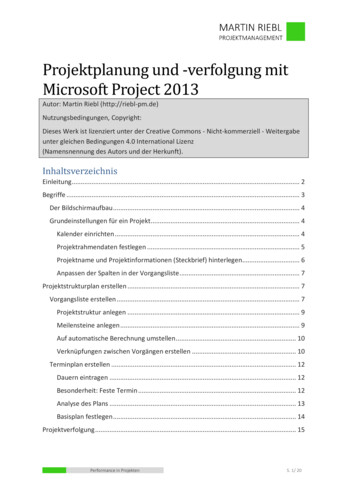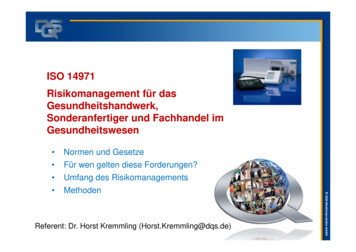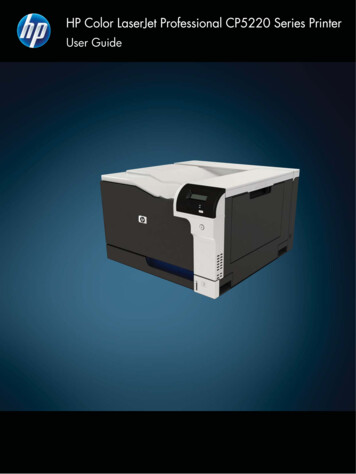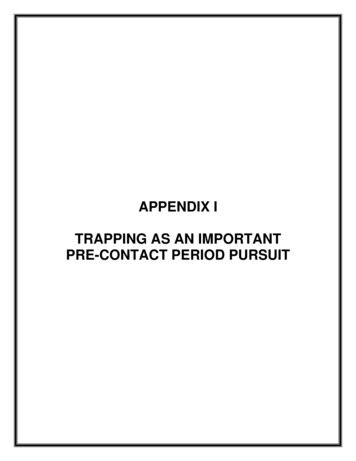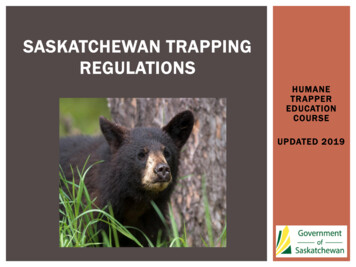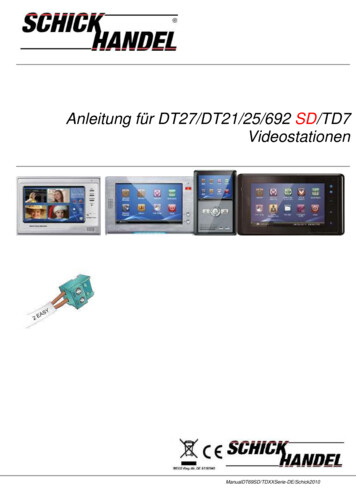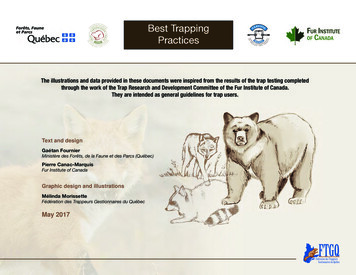
Transcription
Best TrappingPracticesThe illustrations and data provided in these documents were inspired from the results of the trap testing completedthrough the work of the Trap Research and Development Committee of the Fur Institute of Canada.They are intended as general guidelines for trap users.Text and designGaétan FournierMinistère des Forêts, de la Faune et des Parcs (Québec)Pierre Canac-MarquisFur Institute of CanadaGraphic design and illustrationsMélinda MorissetteFédération des Trappeurs Gestionnaires du QuébecMay 2017
TABLE OF CONTENTSKILLING TRAPSGeneral her9Raccoon10Canada lynx11KILLING NECK SNARESGeneral information12Setting principles13Accidental catches (cervidae)14Accidental catches (eagles)15LIVE CAPTURE TRAPSGeneral information16Canids (fox, coyote, wolf)17Raccoon18Canada lynx19Live capture cages20Black bear21-23
Best Trapping PracticesGENERAL INFORMATIONKILLING TRAPSPrinciplesCriteriaApproach angleBABCentred approachfacing the trapPole will control theapproachTrap positionB BSet (angle of approach by the animal, trapposition, trigger position and configuration, trigger adjustment);C Trap Model Mechanical properties (velocity, momentum and clamping forces);DSide hit (avoid) Bad strikeTrigger AdjustmentDQuick (single strike)SingleJ. Goodman DoubleDStrike locations (targeted vital strikezones).Illustrations show rotating jaw traps butcan be applied to other killing type traps.Appropriate strikeStrike typeBUpdate: May 15, 2017Trap dimensions (adapted to the size ofthe animal); Dorso-ventral (ideal)Slow (double strike) AThese criteria and principles apply to species-specifickilling traps. For a list of certified traps for each species,see:fur.ca/certified-traps/J. Goodman fe/trappingregulations/devices/aihts.asp3
Best Trapping PracticesMUSKRATKILLING TRAPSTo Get Optimal Lethal Strike LocationsOn land and submergedStrike TypeSingleBurrow or house entranceRecommended Strike Locations1234 7.7 cm2 Atlanto occipital (neck base)120 frame120 frame6.7 cm3 NeckHead 14ThoraxSemi-submergedGuiding sticks to reduce the opening therebyallowing rapid contact with the trigger4These specifications only apply to killing traps for thisspecies. For a list of certified traps, see:fur.ca/certified-traps/ Approach by the animalUpdate: May 15, ldlife/trappingregulations/devices/aihts.asp
Best Trapping PracticesOTTERKILLING TRAPSTo Get Optimal Lethal Strike LocationsChannel set “submerged”Trail set (on land)Bait or lure set220 and 330frame8.5 to 10.5 cmStrike Types1Single330 frame Double*Trail set“semi-submerged”Recommended Strike Locations234 * Any combination of thorax ④ and strike location ① or ② or ③.3 cm220 frame(neck base)13 cm11.2 cmNeckTrail set (on land)220 and 280 frameHead5Fur Institute of Canada Bait or lure setThese specifications only apply to killing traps for thisspecies. For a list of certified traps, see:fur.ca/certified-traps/ Approach by the animalUpdate: May 15, ldlife/trappingregulations/devices/aihts.asp
Best Trapping PracticesBEAVERKILLING TRAPSTo Get Optimal Lethal Strike Locations“Submerged”Lure Set“semi-submerged”330 frame280 and 330frame280 frameBank hole5 cm2.5 cmLure Set“On land”Strike TypesRecommended Strike Locations1234Single Double* * Any combination of thorax ④ and strike location ① or ② or ③.2 Atlanto occipital (neck base)5 cm10.8 cm8.9 cmHead 13 Neck4Thorax“On land” also6These specifications only apply to killing traps for thisspecies. For a list of certified traps, see:fur.ca/certified-traps/ LureUpdate: May 15, 2017 Approach by the wildlife/trappingregulations/devices/aihts.asp
Best Trapping PracticesWEASELKILLING TRAPSTo Get Optimal Lethal Strike LocationsSingle“Closed” Box trapDouble rotating jaws / baited triggerRecommended Strike LocationsStrike Type1234 Modified Rat Trap2 Atlanto occipital (neck base)3 NeckHead 14Thorax14 cmReduced opening for better selectivity andapproach by the animalPlastic cone to ensurecorrect approach3 cm5 cm3cm9.5 cm6 cm3 cm2 cm2.5 cm2 cm3.5 cm120frameScrews74 cm1.5 cm14 cm1.75 cmThese specifications only apply to killing traps for thisspecies. For a list of certified traps, see:5 cm14 cm BaitUpdate: May 15, 2017 Approach by the ns/devices/aihts.asp
Best Trapping PracticesMARTENKILLING TRAPSTo Get Optimal Lethal Strike LocationsStrike TypesBox set120 frameRecommended Strike Locations1234Single Double* * Any combination of thorax ④ and strike location ① or ② or ③.2.5 cm3 cm8.5 cmHead 12 Atlanto occipital (neck base)3 Neck4Thorax87.6 cm min.12.7 cmThese specifications only apply to killing traps for thisspecies. For a certified traps list, see:polefur.ca/certified-traps/ Approach by the animalUpdate: May 15, 2017 ldlife/trappingregulations/devices/aihts.asp
Best Trapping PracticesFISHERKILLING TRAPSTo Get Optimal Lethal Strike LocationsPole set160frameor1234 220frame2 cm 5 cm2.5 cm5.6 cm9 cm9.5 cmHead 1Small stick between jaws10 cm dia.Recommended Strike LocationSingleWith baited trigger120frame6.5 cm6 cmBox setStrike Type2 Atlanto occipital (neck base)3 Neck4Thorax2 cm911 cm max.10 to12.7 cm8 cm160 12028 cmThese specifications only apply to killing traps for thisspecies. For a list of certified traps, see:1.5 or1.8 m45 to60 Bait Approach by the animalUpdate: May 15, /devices/aihts.asp
Best Trapping PracticesRACCOONKILLING TRAPSTo Get Optimal Lethal Strike LocationsPole set*Box set*or220 frame8.9 cm11.7 cmStrike Type234 280frame14 cm1.9 cm2 Atlanto occipital (neck base)3 Neck15 cm4Thorax3.8 cmHead 16.4 cm1SingleTrail set11.7 cm7.6 cmRecommended Strike Location1010 cm dia.11 cm max.28cm28 cm45 * Trap size and distance between thebait and the center of the trap is a major factor in obtaining atlanto-occipitalstrikes.Center trap on pole for best approach BaitSets above the ground (vertical or horizontal) is to avoid captures by a front legUpdate: May 15, 2017 Approach by the animalThese specifications only apply to killing traps for thisspecies. For a list of certified traps, /devices/aihts.asp
Best Trapping PracticesCANADA LYNXKILLING TRAPSTo Get Optimal Lethal Strike Locations1234 SinglePull triggerSet detailsRecommended Strike LocationStrike Type280 and 330frameTrigger wireString2 Atlanto occipital (neck base)3 NeckHead 14Thorax1110.2 cmUpdate: May 15, 201738 cm38 cmTechnique to encourage lynx to take the bait with itsmouth thus avoiding capture by a front paw.These specifications only apply to killing traps for thisspecies. For a list of certified traps, see: Bait Approach by the ns/devices/aihts.asp
Best Trapping PracticesGENERAL INFORMATIONKILLING NECK SNARESEfficient locks (equipped with a compression spring)Recommended attachment points Camlock dentedAmberg lockSpringFerruleS-HookLoopLoopAlways tie off the snare for the largest possible animal you may catchTo enable the neck snare to close behind the ears and a proper positioning of the lock onthe dorsal part of the neck (see)A highattachment pointFlat washer(optional)Stinger springLockTypes of cable (galvanized steel)Target speciesDiameter(inches)ConstructionBreakingpoint (lb) Lynx/BobcatFox/Coyote1/161/161 x 197x7500480Coyote/Fox5/645/641 x 197x7800650Wolf3/323/321 x 197x71 200920Improving constructionS-Hook (To avoid cervidaecaptures provide better locksliding movement)Senneker trigger(increases clamping force)Update: May 15, 2017Flat loop orswivel12 Use of a neck snare holder (whammy) to provide a sufficient ”temporary” resistanceLockFerruleFlat washerNeck snare holderSwivelSwivel (to avoidcable torsion and breaking)StakeSupport wire
Best Trapping PracticesSETTING PRINCIPLESStricking areas (Canidae Felidae)IdealKILLING NECK SNARESSnare set sites and attachment pointsDensely woodenareaAttachment wirefixed highFlat knot or swivelShort necksnareTo avoidArea where thecarotids andthe trachea aremost exposedLoop diameters and heightsABUpdate: May 15, 2017SpeciesABFox18 cm(7”)18 cm(7”)Bobcat20.5 cm(8”)20.5 cm(8”)Lynx20.5 cm(8”)30.5 cm(12”)Coyote25 cm(10”)25 cm(10”)Wolf35 cm(14”)35 cm(14”)Wolf(Northern)40.5 cm(16”)45.5 cm(18”)Open groundNeck snare holder (Whammy)Position ofsupport wireLong neck snareLock positionedon back of theneck after closingSwivelStakeSupport wireFreed support wireN.B.: On top of these considerations, in order to ensure a rapid loss of unconsciousness and death, killing neck snares must beproperly constructed: efficient locks equipped with compression spring, smallest possible cable wire diameter for the target species.The assembly must produce the best possible mobility (S-Hook) and efficiency of the sliding lock (Senneker trigger, Power snare).13
Best Trapping PracticesACCIDENTAL CATCHES(cervidae, cattle, sheep)KILLING NECK SNARESTo avoid capture and retention of cervidae, cattle and sheep, killing neck snaresmust be constructed and set the proper way.S-HookAccidental catches of moose in neck snaresintended for wolves (nose catch)Diverter; wire no 11 (set details)View from aboveIn a conventionalsetDouble ferruleSide view28”28”15 ConventionalCamlock withS-Hook54 % of the catchesinvolve the nose28”15 Attachmentwire no 9S-Hook openingpoint between 320to 750 lb14Using a diverter wireCamlock with breakaway rivetRivet breakingpoint at 270 lbFlexible neck snareHeavy sliding parts46 % of catchesinvolved the hooves(rear hoof in 2/3 of cases)Stopper ring 10” fromsliding lock(wolf neck snare)Lock S-HookLeg catch rupture produced by S-HookUpdate: May 15, 2017
Best Trapping PracticesACCIDENTAL CATCHES(eagles birds of prey)KILLING NECK SNARESProblems Trapping period critical period for migration Canid enclosure set: High risk trapping technique Solution: Solution:GroundlevelHoles for gaz emanationsANDAND / ORConstruction of open or inverse enclosure setUse of snare sets with scent lure and very small size hidden baits (1 lb/0.5 kg)hidden inside a bait container (plastic tube with holes and lid). Ensure that thebait can’t be released from container.Ex.: Trail crossing**Natural densevegetation edgeLEGEND:*Trail or opening*FieldoropeningBuriedbaitcontainer30 m30 m*No snare set in this areaMade-up trail in densevegetation or woodlandN.B.: the open surface must allow the birds of prey to easily land and take off close to the bait(if exposed to their sight)Attractant: (lure) (small size bait hidden close to the ground in a bait container)Position of neck snaresAccess roadUse of trail sets(no bait)Scent emanations pipeSolution Use of a adapted bait container(eg. Steel bucket with lid)Buried bait containerHand made trailExisting trail or dense vegetation edgeFor more information on proper birds of prey handling and rehabilitation techniques, consult: uqrop.qc.ca/en/Update: May 15, 201715
Best Trapping PracticesGENERAL INFORMATIONLIVE CAPTUREElements of Trapping to Avoid Injuries / Limb Holding TrapsDaily check of the trap setsJaw type traps and certain footsnares.Produces an appropriate strike locationProper adjustment of the pan trigger.Jaw type traps Foot encapsulatingCentre mounted swivelBend here foradjustmentJaw Type Traps, Footsnares, Foot Encapsulating TrapsJean-François Houle Use of swivels avoids injuriesby twistingShock absorberspringsAll limb holding trapsfor raccoon and lynx:use stake anchoringsystemsStrong (coyote, wolf)Movement radius chain length X 216Regular (fox)Canids, lynx, raccoon:With a stake, use short chain or cableCanids jaw trap only:With a drag anchoring system, use a long chain(see Canids sheet)Stake or drag trap anchoring:Use an inline shock absorber spring and a sufficientnumber of swivels Swivel Shock absorber springUpdate: May 15, 2017These specifications only apply to the species-specificlive capture traps. For a list of certified traps for eachspecies, /devices/aihts.asp
Best Trapping PracticesCANIDS (fox, coyote, wolf)LIVE CAPTUREFOOTSNARE / JAW TYPE TRAPTrap Set Details to Avoid InjuriesFootsnaresJaw type trapOptimal Strike Locations(set)Résultante(not set)12 31 Toes2 Pad3 WristShock absorberspringsCentre mounted swivelRecommended anchoring chainmaximum lengthMobile (drag)Jaw type trap andfootsnaresJean-François Houle Use of swivels avoids injuriesby twistingStrong (coyote, wolf)Regular (fox)StakeFox1.5 m0.3 mCoyote2.5 m0.5 mWolf3m1.2 m17321Use of at least one shock absorber spring and a sufficientnumber of swivelsStakeMovement radius chain length X 2With a stake, use short chain orcable (see table)With a drag anchoring system, use along chain (see table) SwivelN.B.: For all footsnare cable, use stake only, no drag Shock absorber springFor more details, check the PIGEC manual (ftgq.qc.ca/fr/publications/index.htm)Update: May 15, 2017These specifications only apply to the live capture trapsfor these species. For a certified trap list for coyote andwolf, /devices/aihts.asp
Best Trapping PracticesRACCOONLIVE CAPTUREFOOT ENCAPSULATING TRAPSTrap Set Details To Avoid InjuriesLil’ Grizz Get’rzOptimal Strike LocationEgg trap1- Bait set under pulltrigger23 60 - Positioned this way,the restraining arm(steel rod) strikes onthe pad sideLightcompacted soilFor all trap models:Duffer1 ToesIdeal raccoonapproach angle- Short chaining system- 2 swivels- Stake anchoring system2 Pad3 WristObstaclebehind the trap123Duffer and Egg trap:Compacted- Partly buried underground(compacted soil)- Bait set on the triggerCompactedsoilThese specifications only apply to the live capture trapsfor this species. For a list of certified traps, see:fur.ca/certified-traps/ Approach by the animalUpdate: May 15, 2017 wildlife/trappingregulations/devices/aihts.asp18
Best Trapping PracticesCANADA LYNXLIVE CAPTUREFOOTSNARE / JAW TYPE TRAPTrap Set Details to Avoid InjuriesOptimal Strike Locations12 31 ToesFavour this type ofstrike.2 PadTrap anchoring3 Wrist- Stake only- Short (max. length 24.5 cm).To obtain this strike, properlyposition the trap19Centre mounted swivel2 swivels shock spring123These specifications only apply to the live capture trapsfor this species. For a list of certified traps, see:Set only for capture by one front foot Approach by the animalUpdate: May 15, 2017 ns/devices/aihts.asp
Best Trapping PracticesGENERAL INFORMATIONLIVE CAPTURECAGESCAGEInstallation Details Cage set in the shade and ifpossible protected from badweather and to preventexposure to sun andhypothermia; Daily check, early morning; If set close to water edge, anticipate water level fluctuationsto avoid drowning; Choose quiet trap sites toavoid stress.Update: May 15, 2017gutterFor a list of raccoon certified traps, /devices/aihts.asp20
Best Trapping PracticesBLACK BEARMAX. 24 HOURS TRAP CHECKLIVE CAPTUREDFootsnareFOOTSNAREFMobile Anchor SystemsShock absorbing spring (250 lb)B13/64” ØCChain with 1/4” (grade 30) linksF110 5/16” ØF2.4 m (8’)DESteel cable 7 x 19, 3/16” ØABBSpecifications:A. Flexible steel cable, construction 7 x 19,3/16” diameterB. Double ferrule 3/16”C. Lock: 110 angle, 3/16” thickness, 5/8” width,rounded edges (single use)D. Swivel: minimum 880 lb testE. Diameter of 6” and less (bucket set)8” and less (trail set)F.Quick link (1 660 lb test)IMPORTANT: fixed anchor ensures a more reliableoperation of the footsnare swivel.Update: May 15, 201721Fixed Anchor Systemswith steel cable 3/16” Ø or chain (1/4” links)Bucket SetBTrail Set1.2 m (46”) or lessSolid tree,min. 6” Ø60 cm (24”) or lessDBThe cable or the chain must turn freely aroundthe treeD
Best Trapping PracticesBLACK BEARLIVE CAPTUREFOOTSNARE /FIXED ANCHOR SYSTEMSTHE SWIVEL MUST ALWAYS BE FUNCTIONALBUCKET SETTRAIL (GROUND) SETTie wrap 50 lbAnchoring cable:total length 1.7 m(66”)Swivel12.5 cm(5”)The bucket lidMUST besecured(screws)Bucket: minimumdepth of 38 cm (15”)No hole inthe bucketSwivel1.2 m(4.5’)The bucketmust easilyfall to theground oncethe bear iscapturedBait and moveablebranches guiding thebear to ensure anapproach by the frontUpdate: May 15, 20171 m (buffer zone)(B)SwivelScrew 1 ½”Baittiedto thebottom(A)SwivelCatch CircleWood screw 1 ½”Sweetbait(C)Bear trailTie wrap 50 lbBackabout1 ½”lowerthan thefrontDiameter anchoring cable (A) footsnare length when closed (B) 1 m (C)The anchoring system mustturn freely around the solid tree(minimum 6” Ø)22
Best Trapping PracticesBLACK BEARLIVE CAPTUREFOOTSNARE /MOBILE ANCHOR SYSTEMSTHE SWIVEL MUST ALWAYS BE FUNCTIONALBUCKET SETTRAIL (GROUND) SETTie wrap50 lbAnchoring mobilelog (drag) 18 cm Ø (7”),1.8 m (6’)lengthSwivelShockabsorbingspring(250 lb)SwivelBear trailTie wrap 50 lb12.5 cm(5”)12.5 cm(5”)SwivelSweetbaitsTie wrap 50 lb1.2 m(4.5’)Sweetbaits1.2 m(4.5’)Solid tree,min. 4” ØShock absorbingspring (250 lb)IMPORTANT: the tie wrap ensures a complete and fastclosure of the footsnare cable around the bear’s front limb.IMPORTANT: always guide the bear to approach from the front of the trap.Update: May 15, 201723
CopyrightFédération des Trappeurs Gestionnaires du QuébecFur Institute of CanadaMinistère des Forêts, de la Faune et des Parcs (Québec)PUBLISHED BY THEFédération des Trappeurs Gestionnaires du QuébecMay 2017 (2nd edition)LEGAL DEPOSITBibliothèque et Archives nationales du Québec 2017ISBN: 978-2-924030-20-2 (printed version)ISBN: 978-2-924030-21-9 (PDF)
KILLING TRAPS General information Muskrat Otter Beaver Weasel Marten Fisher Raccoon Canada lynx KILLING NECK SNARES General information Setting principles Accidental catches (cervidae) Accidental catches (eagles) LIVE CAPTURE TRAPS
